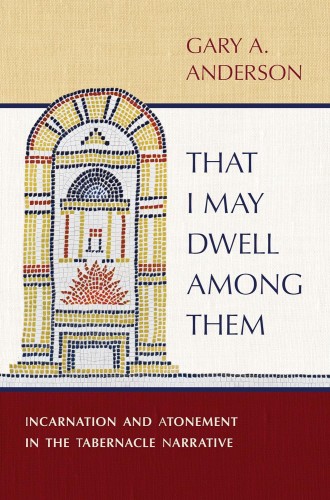Deep insights for Christians—from Leviticus
Gary Anderson thinks that the answer to what ails contemporary Christian theology lies tucked away in the Torah’s tabernacle narrative.

That I May Dwell among Them
Incarnation and Atonement in the Tabernacle Narrative
Recently, a parishioner of mine proudly reported that she and her husband had started reading through the Bible, beginning with Genesis 1. You won’t be surprised at my warning to her: watch out for Leviticus.
Gary Anderson has heard it before. The Notre Dame professor has long been in love with the tabernacle narrative in Leviticus 1–10, although he acknowledges that “most readers are not!” Many Christians have asked Martin Luther’s question about the difficult parts of the Old Testament: What do we do with these objectionable stories now that Christ has come? Devotees of Old Testament scholar Brevard Childs, such as Anderson, ask instead: Given what we know of God’s promises to Israel, how do we make proper sense of the New Testament?
Read our latest issue or browse back issues.
Anderson himself is more ambitious still. He thinks that the answer to what ails contemporary Christian theology lies tucked away in Leviticus, hiding in plain sight.
This book bristles with insight, so I can only hit the highlights. One harmful way for Christians to recover the tabernacle narrative, Anderson argues, is to read our doctrine of the atonement back into it. The sacrifices in the temple are not primarily to atone for sins. They create something positive in their own right, something that human sin counteracts. While Anderson is not against specifically Christian readings of Old Testament texts, he believes the texts should first be read on their own terms, with their own voice.
Such metaphors as “in their own right” and “on their own terms” allow Anderson to trace the priestly material from its origins, with historicist insight but not blinders, using midrashic resources as well as Christian. The results are often rich christological readings that follow the proper order. Figural reading yields such pluriform treasures. Anderson sees the story line of the whole Bible in the tabernacle narrative: God means to dwell with humanity, to be served by human hands, from the tabernacle to the Theotokos.
Anderson understands the mundane and repetitive detail about the construction of the tabernacle as analogous to a cello once used by a great maestro or sports memorabilia treasured by fans. The tabernacle is the house in which God dwells. He consumes the sacrifices. The furniture and fixtures make up the divine domicile. These handmade things are porous to the divine presence, and so they are rightly venerated—even by as fiercely an aniconic tradition as Israel’s. God has no need of a house or food or furniture on his own, of course. But God condescends to be housed by us, to dwell in things we make, and so to consummate creation with his own indwelling. Jews agree with Christians that creation doesn’t conclude with the first sabbath. For them it culminates with God’s indwelling at Sinai and the temple.
Anderson spends several chapters on the misdeeds of Aaron’s sons—two of whom end up vaporized, two more merely rebuked. Both penalties are perplexing. Anderson suggests that the reasoning behind them is obscured on purpose, in analogy to the veiling of the holy of holies. Even with divine willingness to dwell with us, God will not be co-opted or manipulated. God is still dangerous. And the biblical writer draws a sort of literary veil over the precise nature of the “strange fire” that dooms poor Nadab and Abihu, like the temple’s own curtains. We are not meant to see or know.
Here Anderson appeals to Pseudo-Dionysius the Areopagite’s praise of apophatic theology as a hedge against idolatry. The more important theological point is the same one made in the golden calf story: no sooner is God dwelling with us than we fracture the relationship with idolatry. There is no golden age of happy presence; there is instead what Anderson calls “immediate sin.” It’s hard to imagine another Old Testament scholar drawing on a patristic source such as Dionysius or coming as close to defending the doctrine of original sin as Anderson does.
My favorite portion of this book lingers on a patristic reading strategy: what the New Testament tells us briefly or in passing we can learn about in more depth and leisure from the Old. For Athanasius, the New Testament doesn’t shine a light on the Old Testament’s dark corners. Rather, the New Testament is in a hurry, and readers who want more depth should go luxuriate in Israel’s scripture. (Anderson notes that Michelangelo understood this principle: his painting of Ezekiel in the Sistine Chapel has the prophet’s book on his knee, while he startles at the realization of Jesus’ fulfillment. Ezekiel has endless value on its own. Its surprising continuity and fulfillment in Christ baffles its author and us.)
Believing the Old Testament to illuminate the New, the early church would often analogize between the holiness of the tabernacle or temple and Jesus’ own body. This analogy became problematic, however, when Nestorians used it to argue that just as the divine presence leaves the temple in Ezekiel, so are the two natures of Christ separable. So tabernacle and temple imagery shifted to Jesus’ mother. Traditions in which Mary—the “container of the uncontainable”—is analogous to the ark or temple tell us about her body’s holiness.
Anderson’s final chapter takes aim at clumsy notions of penal atonement, in which the Father punishes the Son instead of us. It’s common for ecumenical theologians to counter this theology by appealing to the Eastern Orthodox tradition of divinization. In this view, salvation is not a matter of transferred punishment; it is about humanity becoming divine like Christ. Fair enough, Anderson argues, but such correction tends to lose sight of the costliness of sacrifice. Anderson finds it—without any risk of absurd notions of divine child abuse—in the daily offering at the temple, the Tamid. He notes that the Tamid is connected to the binding of Isaac, both textually and liturgically. In Genesis 22, Abraham offers not just his son but his own future, his own self—and God provides a ram, who is offered instead. The offering of a ram is repeated in the Tamid, and thus Israel offers up Isaac all over again twice a day. God asks for us to make the offering, and then God also provides the sacrifice himself. While Anderson mutes the christological significance of this, his readers need not.
Anderson is not given to triumphalist rhetoric or self-promotion, so let me do it for him: every preacher needs to read not just this book but all of Anderson’s work. He is the essential theological interpreter of the Old Testament today. Now that I’ve read That I May Dwell among Them, I am eager to return to my Leviticus-reading parishioners and tell them: just wait until you get to chapters 9 and 10. They explain everything.





